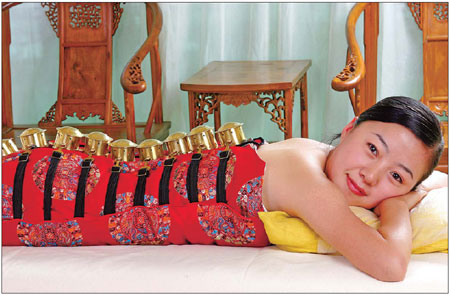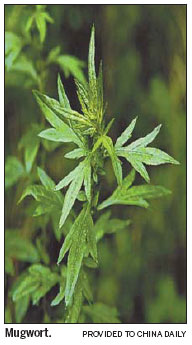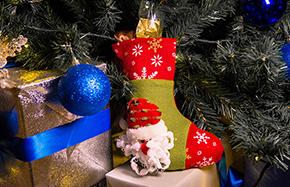Moxibustion is hot
 |
|
In indirect moxibustion, a practitioner uses a lit mugwort stick or a can with burning mugwort, to warm the desired points.[Photo/China Daily] |

The traditional Chinese medicine therapy using moxa, or mugwort herb, is once again becoming fashionable. Liu Zhihua reports.
No matter how busy she is, a 43-year-old Beijing-based entrepreneur regularly visits Guo Ai Tang, a moxibustion center near her home.
Xi, who declines to give her full name, established the weekly routine early this year when seeking traditional Chinese medicine (TCM) therapy to ease pain caused by a three-year-old mammary gland hyperplasia - a benign, often drastic enlargement of the mammary glands.
Previously, she had turned down an operation suggested by her doctor to remove the apricot-stone-sized lump.
"The idea of an operation was repellant and I recalled that when I was a kid, my grandmother used to have moxibustion when she fell ill," Xi says.
On her first visit to Guo Ai Tang, which she chose for its location and reputation after an online search, she filled in a questionnaire about common physical irritations, and had a brief conversation with a practitioner.
To her great surprise, the practitioner figured out her illness.
She was directed to go into a private room playing soft music, change into pajamas and lie down.
A moxibustionist lit one end of a moxa stick, or dried mugwort herb, roughly the shape and size of a cigar, and held it close to the skin to heat four acupuncture points, one after the other, each for about 15 to 20 minutes.
At the same time, several small cans containing burning moxa were placed on other five acupuncture points to warm up the areas.
When the skin became too hot, the practitioner stroked the area to ease discomfort.
The process lasted about 80 minutes, including a 10-minute massage.
To date, Xi has received two courses of therapy, each of 10 treatments.
"About two months ago I started to undergo moxibustion therapy and TCM and now the lump in my breast is gone," Xi says.
"I felt so relaxed during treatment that I often fell asleep. I didn't expect the effect to be so stunningly good," Xi says.
Moxibustion, although not so popular as acupuncture, is actually older as a practice.
Li Weiheng, president of China Association of Acupuncture and Moxibustion, says moxibustion appeared as soon as Chinese learned to use fire, and gradually became one of the first methods used to fight disease and keep fit in ancient times.
It was believed that moxibustion directly replenishes yang energy in the body to alleviate conditions caused by a deficiency of the yang factor, such as indigestion, shortness of breath, fatigue, menstruation pain and problems with the neck, shoulders, waist and legs.
In the Tang (AD 618-907) and Song (960-1279) dynasties, the popularity of moxibustion reached a peak among people from all walks of life.
However, the therapy declined during the Qing Dynasty (1644-1911), when the emperors' doctors believed it was indecent for him to expose his body to acupuncture and moxibustion.
After the foundation of the People's Republic of China, moxibustion was lumped with TCM, and lagged behind acupuncture in terms of global exposure.
Today, it is generally accepted, there are two forms of moxibustion: direct and indirect. In the former, a small amount of mugwort is placed on top of an acupuncture point and burned. This form of moxibustion is further defined as scarring and non-scarring.
With scarring moxibustion, the mugwort is placed on a point, ignited and burns out completely, which will lead to blisters and scarring after healing.
With non-scarring moxibustion, the mugwort is extinguished or removed before it burns the skin.
In indirect moxibustion, a practitioner uses a lit mugwort stick or a can with burning mugwort, to warm the desired points, which is the therapy Xi underwent.
Although acupuncture is widely done by both Chinese and foreigners, moxibustion is not so highly regarded, especially in hospitals.
"Most hospitals don't practice moxibustion," says Guan Ling, an acupuncture and moxibustion specialist with the 301 Military Hospital in Beijing.
The reasons, she explains, are that moxibustion, which requires one-on-one service, is time- and energy-consuming and therefore not profitable, and people are not willing to tolerate the smoke or scarring.
The recent resurgence of moxibustion is largely due to indirect moxibustion.
Six years ago, Kang Liguo, at that time a sales manager at a major IT company, led such a full working and social life that his health started suffering.
He underwent a course of moxibustion therapy and to his great surprise, found his health much improved.
Inspired and curious, Kang learned all he could about moxibustion and was fascinated by its history. He finally decided to quit his job.
"I saw a great business opportunity, for I believed in the effects of moxibustion," Kang says.
In 2005, he founded a company selling moxibustion tools and training programs, and in 2007, he opened Guo Ai Tang, in Beijing, which now has three branches.
"Guo Ai Tang is one of the earliest moxibustion centers in Beijing, even in China," Kang says.
"At first, people knew little about moxibustion and we needed to explain, to encourage people to try it out. Now, dozens of moxibustion centers are emerging and more people are enjoying its benefits.
"I'm encouraged. As a businessman I want to make money first, but I'm also glad the ancient therapy is acquiring new life."
















